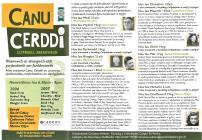Content can be downloaded for non-commercial purposes, such as for personal use or in educational resources.
For commercial purposes please contact the copyright holder directly.
Read more about the The Creative Archive Licence.
Description
Lede
Fairies are frequent characters in stories from across Wales. The fairies known as Plant Rhys Ddwfn sometimes appear as mermaids in Pembrokeshire folklore.
Story
In Pembrokeshire, fairies are commonly known as Plant Rhys Ddwfn, the ‘children of Rhys the Deep’, ‘deep’ here referring to depth of character. This particular tribe or type of fairies are of diminutive size like that of a 5- or 6-year old child. Sometimes, the females are half human and resemble mermaids. They are said to live on a number of islands stretching across Cardigan Bay, from Pembrokeshire in the south to the Llŷn peninsula in the north. Rhys Ddwfn’s island realm is invisible to the human eye, except when viewed from one particular spot at Pen Cemaes, about 20km north of Fishguard. According to legend, a special herb grows in a patch no more than a metre wide; from that viewpoint, the islands would uncover themselves to human eyes.
For a long time, the Plant Rhys Ddwfn went to market in Cardigan. No one ever saw them coming or going; they were just there, gladly paying the traders good money for the wares on offer. Whenever prices were high on market day, it was said that the Plant Rhys Ddwfn had been in town. This did not make them favourites with other buyers, who had trouble stretching their little money to make necessary purchases, and so the fairies started visiting Fishguard market instead. In 1896, the Pembroke County Guardian reported the statement of a Fishguard woman who acknowledged their presence, however further to the east, saying, ‘There are fairies for they came to Ha’rfordwest market to buy things, so there must be.’
On other occasions, the Plant Rhys Ddwfn appeared around the Fishguard area as mermaids sitting on rocks and combing their hair. In 1858, Daniel Huws supposedly encountered a mermaid between St David’s and Fishguard. Except for her fishtail she was said to look ‘like the lasses of Wales’ and spoke Welsh to the men who approached her, before she disappeared back into the sea. At another occasion, a mermaid was spotted outside Fishguard at Llanwnda, where in 1798 the French had made an unsuccessful attempt at invading Britain. The men who saw her abducted her and took her home with them. She only regained her freedom in exchange for three bits of advice which were remembered in the family ever afterwards.
In 1910, another local newspaper, The Pembrokeshire Herald and General Advertiser, reported a strange occurrence in Pencaer, Fishguard. A heavily veiled woman barged into Garnfawr Cottage, which at the time was empty except for a little girl. The girl watched the woman go from room to room, rifling through all the family’s possessions as if she was searching for a lost item, but taking nothing. She then climbed the ladder to the crog loft, but was trapped by the little girl removing the ladder. Despite this, the woman escaped by jumping through one of the windows and leaving no trace. Owing to her odd dress and behaviour, it was thought that Garnfawr Cottage had been visited by a mermaid who had emerged from the sea at nearby Pwll Deri.
Factoid
- Rhys Ddwfn’s invisible island realm roughly overlaps with Gwyddno Garanhir’s ancient drowned kingdom, the famous Cantre’r Gwaelod of Cardigan Bay.
- There have been suggestions that the Plant Rhys Ddwfn are, in fact, Irish traders who crossed the Irish Sea to sell their wares at Welsh markets.
- The island Grassholm, in Welsh Gwales, is one of the mythical islands in the Mabinogi. According to legend, Bendigeidfran’s head rested here for 80 years after his battle against the Irish King Matholwch. Grassholm is believed to be part of Rhys Ddwfn’s kingdom.





Do you have information to add to this item? Please leave a comment
Comments (0)
You must be logged in to leave a comment